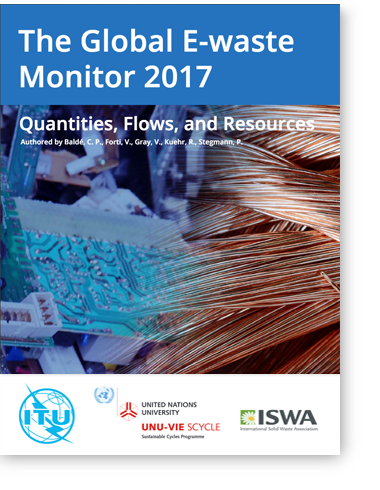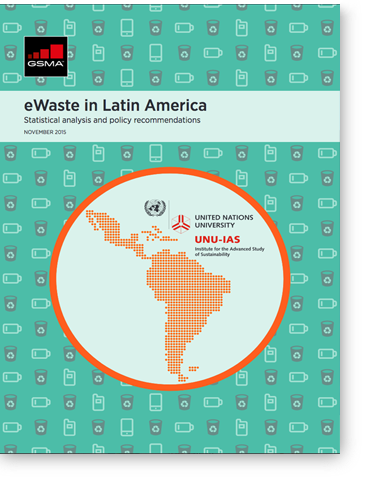The Global E-waste Monitor 2020 – Quantities, flows, and the circular economy potential
The Global E-waste Monitor 2020 (www.globalewaste.org) is a collaborative product of the Global E-waste Statistics Partnership (GESP), formed by UN University (UNU), the International Telecommunication Union (ITU), and the International Solid Waste Association (ISWA), in close collaboration with the UN Environment Programme (UNEP). The World Health Organization (WHO) and the German Ministry of Economic Cooperation and Development (BMZ) also substantially contributed to this year’s Global E-waste Monitor 2020.
A record 53.6 million metric tonnes (Mt) of electronic waste was generated worldwide in 2019, up 21 per cent in just five years, according to the UN’s Global E-waste Monitor 2020, released today. The new report also predicts global e-waste – discarded products with a battery or plug – will reach 74 Mt by 2030, almost a doubling of e-waste in just 16 years. This makes e-waste the world’s fastest-growing domestic waste stream, fueled mainly by higher consumption rates of electric and electronic equipment, short life cycles, and few options for repair. Only 17.4 per cent of 2019’s e-waste was collected and recycled. This means that gold, silver, copper, platinum and other high-value, recoverable materials conservatively valued at US $57 billion – a sum greater than the Gross Domestic Product of most countries – were mostly dumped or burned rather than being collected for treatment and reuse.
According to the report, Asia generated the greatest volume of e-waste in 2019 — some 24.9 Mt, followed by the Americas (13.1 Mt) and Europe (12 Mt), while Africa and Oceania generated 2.9 Mt and 0.7 Mt respectively. For perspective, last year’s e-waste weighed substantially more than all the adults in Europe, or as much as 350 cruise ships the size of the Queen Mary 2, enough to form a line 125 km long. E-waste is a health and environmental hazard, containing toxic additives or hazardous substances such as mercury, which damages the human brain and / or coordination system.

Monitor Features
1. What is E-waste?
Definition, product categories, disposal routes, key issues
5. E-waste Legislation and Transboundary Movements
Legislation and policies in place; imports & exports of e-waste
2. Global E-waste Key-statistics
Development of global e-waste mountain
6. E-waste and Circular Economy
Potential of urban mining and closing loops
3. E-waste and SDG
E-waste as sub-indicator for the Sustainable Development Goals
7. E-waste and Health
Health consequences mainly from improper treatment of e-waste
4. Measuring E-waste
How to measure e-waste from a statistical point
8. Regional E-waste Status and Trends
Country specific estimates of e-waste generation.
Book Preview
About the authors

Vanessa Forti
Vanessa FORTI is a Programme Associate at UNU-Vie-SCYCLE. Vanessa's research is focused on waste quantification and the evaluation of its impacts, and she is the author of various publications that focus on quantifying e-waste amounts and environmental impacts, such as the 2017 edition of the Global E-waste Monitor 2017 (Baldé et al. 2017) and the globally recognised E-waste Statistics Guidelines on classification, reporting and indicators (Forti et al. 2018). The Global E-waste Monitor 2017 won the European Advanced SDG award from the Diplomatic Academy in Vienna. She is responsible for the regular update of methodologies, programming, data collection, surveying, modelling, and reporting on waste statistics (e-waste, mercury, and battery waste), and she attained the role of Data Manager within the SCYCLE team. In addition, she has co-developed EEE Placed on Market and WEEE Generated tools and manuals that are used globally. She is also a member of the Global E-waste Statistics Partnership, which works to help countries produce e-waste statistics and to build a global e-waste database for tracking developments over time. She is in charge of organizing, developing, and conducting capacity-building workshops on e-waste statistics and building institutional capacity on e-waste in developing countries. Vanessa holds a Master's degree in Environmental Engineering from Università degli Studi di Bologna, where she graduated cum laude.

Dr. Cornelis Peter Baldé (Kees)
Dr. Cornelis Peter BALDÉ (Kees) is a Senior Programme Officer at the Sustainable Cycles Programme at the United Nations University. At the UNU, Kees’s main tasks are to lead the statistical work, build institutional capacity on waste statistics in various countries, and waste policies, provide policy advice on e-waste to countries, and supervise staff and the strategic development of the team. He is one of the founders of the Global E-waste Statistics Partnership. Kees is currently the co-chair of the Taskforce on Waste Statistics of the UNECE Conference of European Statisticians that is tasked with developing a framework for waste statistics that is sufficient for monitoring current and future circular economy policies as well as waste policies. Additionally, Kees has been selected by the Dutch government as a member of the board of directors of the Dutch Waste Electronical and Electronic Appliances Register, a role he has held since 2015. In 2018, the Global E-waste Monitor 2017 won the European Advanced SDG award from the Diplomatic Academy in Vienna. At Statistics Netherlands, Kees received the Innovation Award for the Dutch Green Growth publication in 2012. Previously, Kees worked at Statistics Netherlands as the deputy head of the Environment Statistics team. He earned his PhD on hydrogen storage at the Faculty of Chemistry at Utrecht University.

Dr. Ruediger Kuehr
Dr. Ruediger KUEHR is Director of the UNU Vice Rectorate in Europe, Sustainable Cycles Programme (SCYCLE), focusing its work and activities on sustainable production, consumption, and disposal. Ruediger co-founded the Solving the E-waste Problem (StEP) Initiative and functioned as its Executive Secretary from 2007-2017. From 1999-2009, he served as Head of the UNU Zero Emissions Forum (ZEF) – European Focal Point, and from 2000-2002 he was Secretary to the Alliance for Global Eco-Structuring (AGES) under UNEP’s Cleaner Production Network. Ruediger has co-authored and co-edited several books, studies, and proceedings, including the previous Global E-waste Monitors in 2014 and 2017. He also publishes and lectures on, inter alia, environmental technology transfer, transnational environmental policies, strategic sustainable development, and development cooperation. Ruediger has also been the Project Manager of the “2008 Review of Directive 2002/96/EC on waste electrical and electronic equipment (WEEE)” (2007). A political and social scientist by education with a PhD (Dr. rer. pol.) from the University of Osnabrück (Germany) and an MA from the University of Münster (Germany), as well as additional post-graduate studies in Tokyo, (Japan), he has served as Senior R&D Specialist with The Natural Step in Sweden and as a freelance policy-consultant to various national governments.

Garam Bel
Garam BEL is the E-waste Officer for the Telecommuni-cation Development Bureau (BDT) of the International Telecommunication Union (ITU), based in Geneva. Working in the Environment and Emergency Telecommunications Division (EET), he oversees the e-waste activities of BDT, covering policy development and awareness-raising. As part of the Global E-waste Statistics Partnership, Garam coordinates the input from BDT on capacity-building and awareness initiatives relating to e-waste quantification. Prior to joining ITU, he worked for the Environment Management Group, which is a system-wide UN coordination body on environment and human settlements. In this position, he led activities towards streamlining the various e-waste-related initiatives of UN agencies and programmes. Before moving to Geneva, Garam worked for a local government in Scotland in the area of municipal solid waste. He holds a master's degree in Standardization, Social Regulation and Sustainable Development from the University of Geneva.
Other E-waste Data Resources
Regional E-waste Monitor Asia 2016
• Regional E-waste Monitor 2016: East and Southeast Asia
E-waste in Latin America
• eWaste in Latin America 2015: Statistical analysis and policy recommendations.











